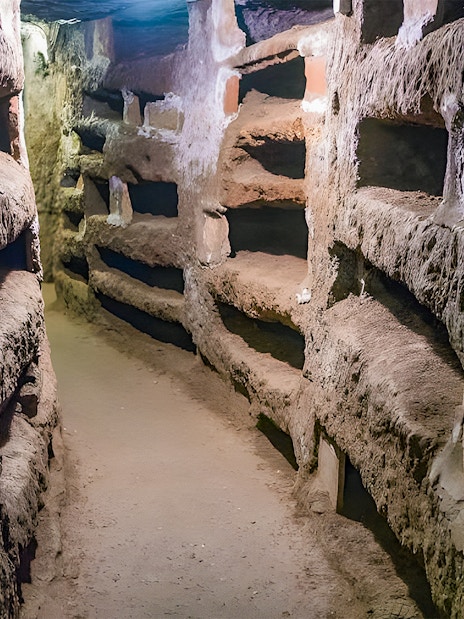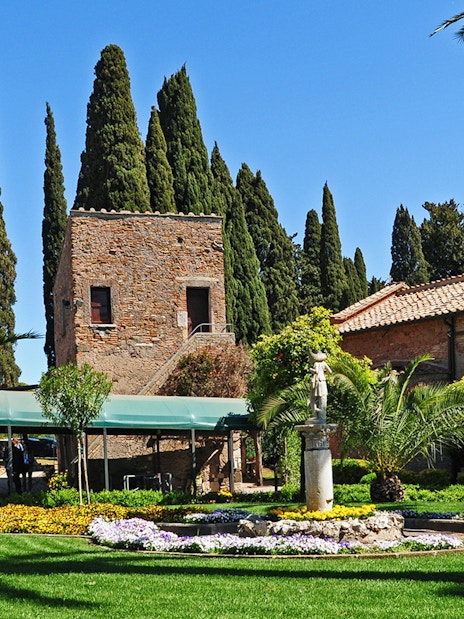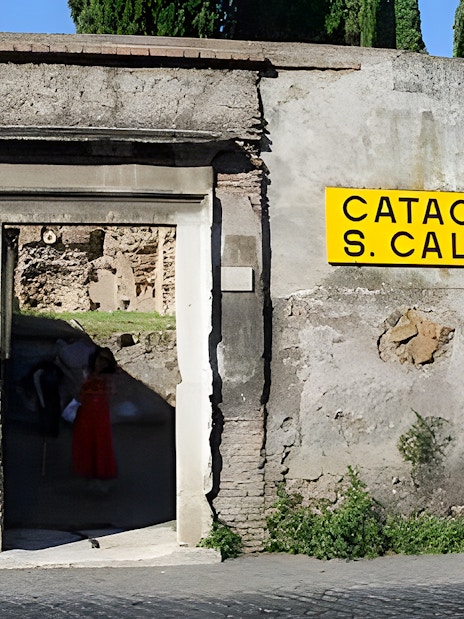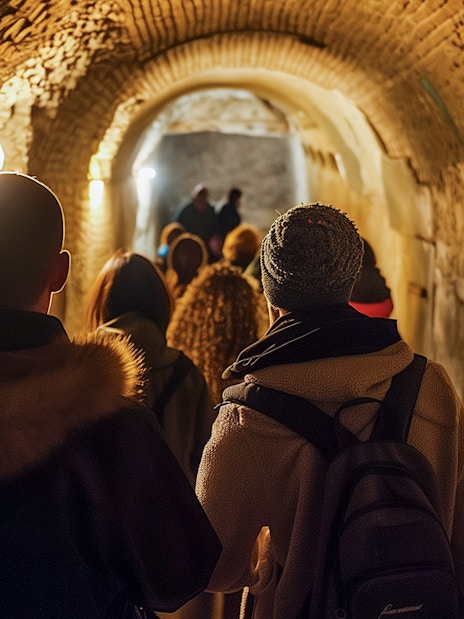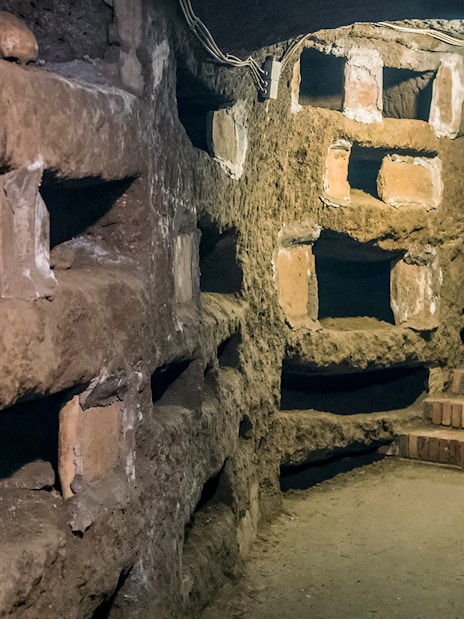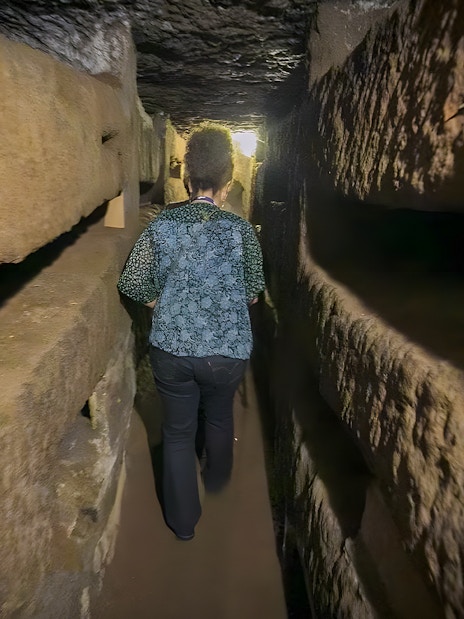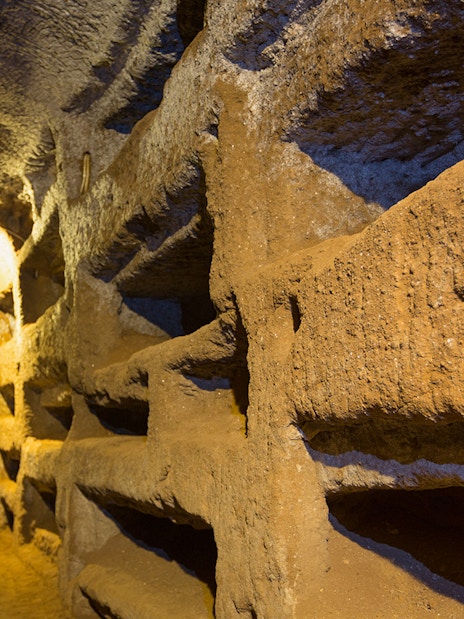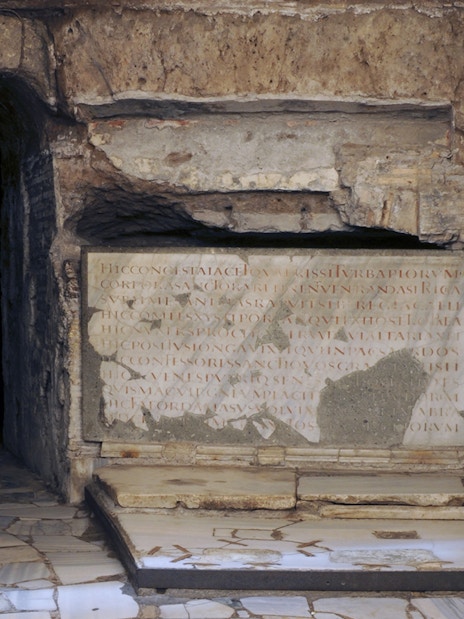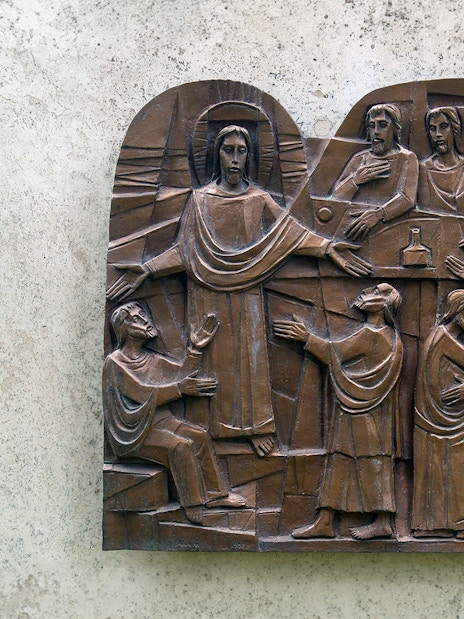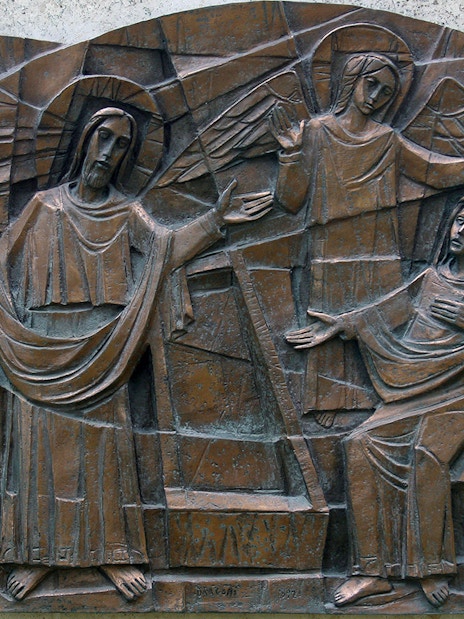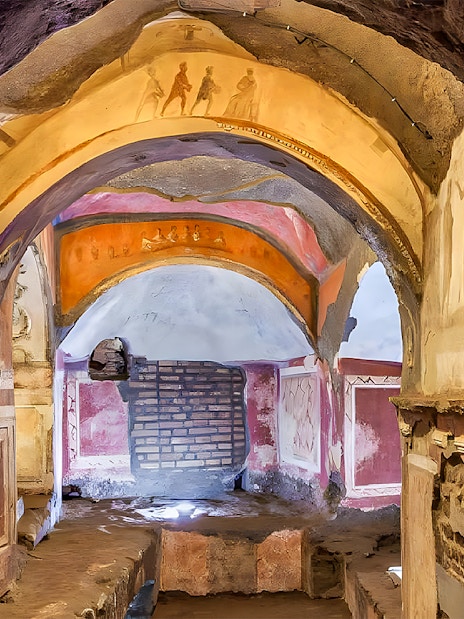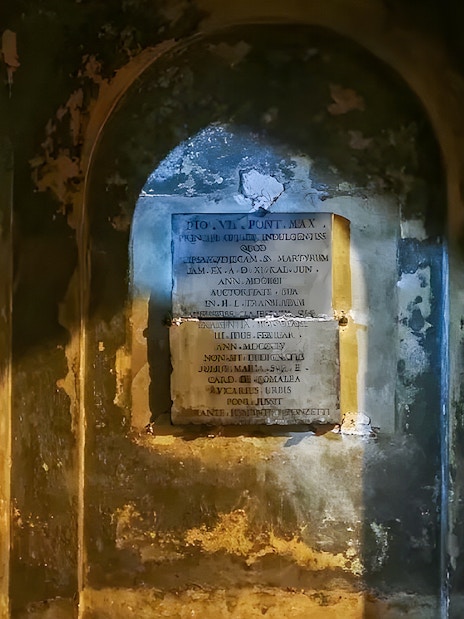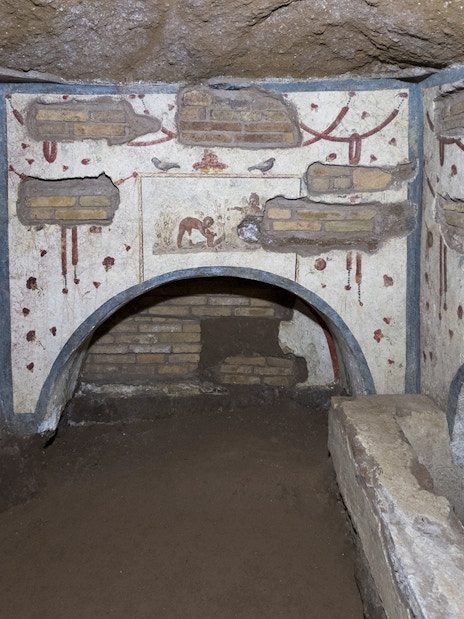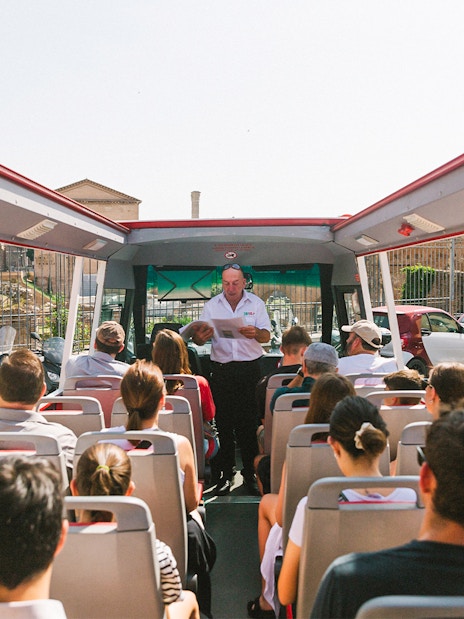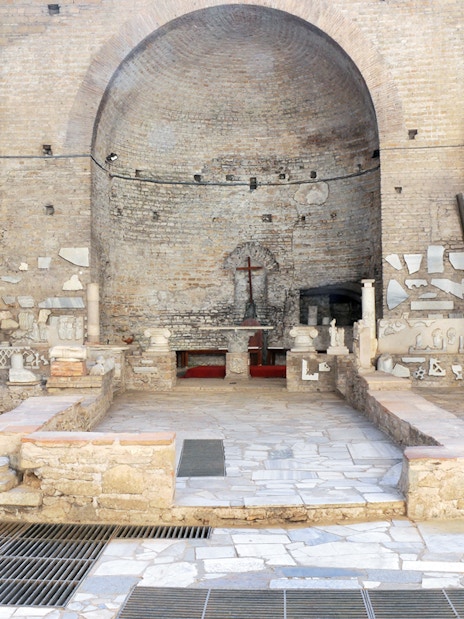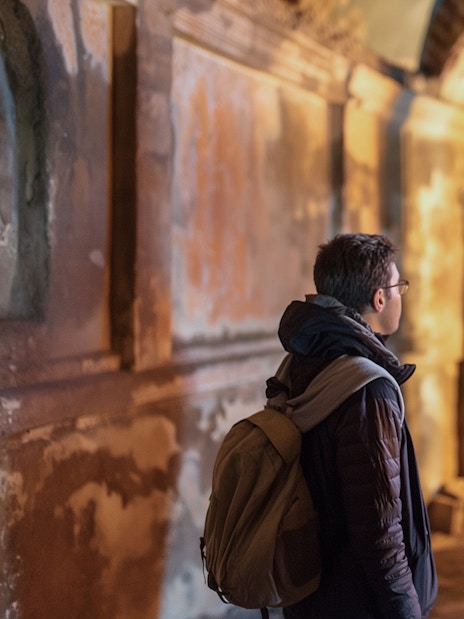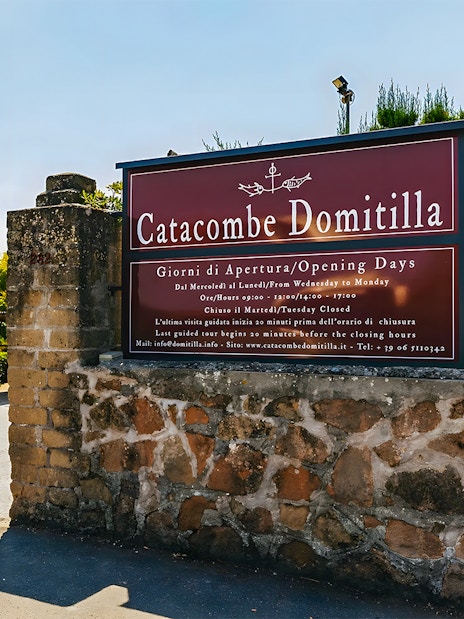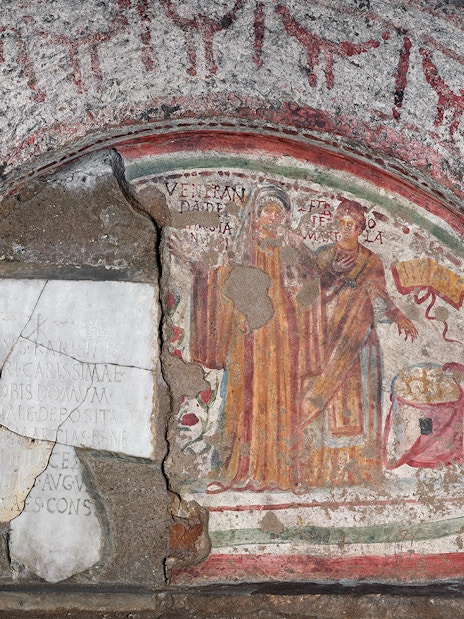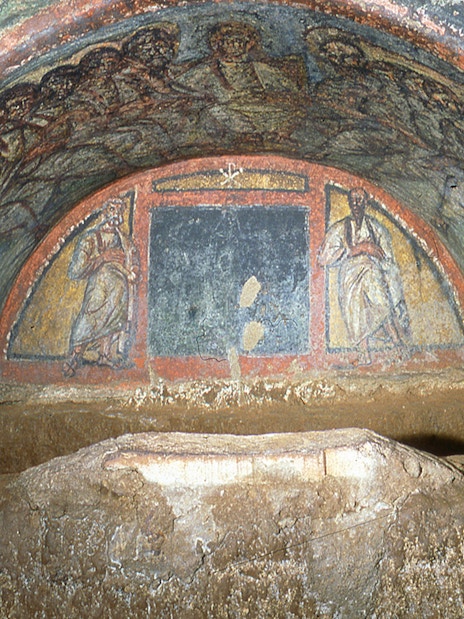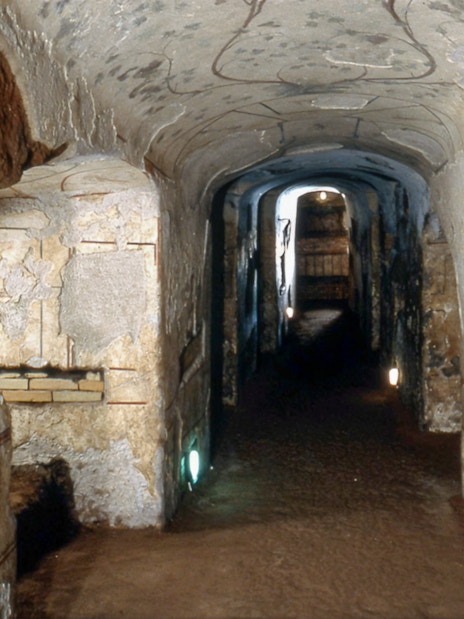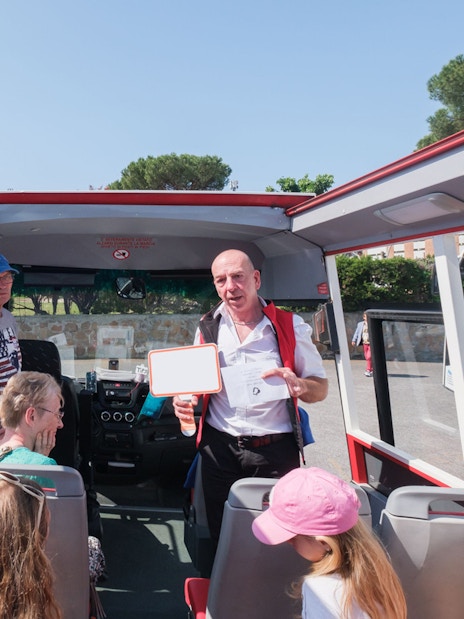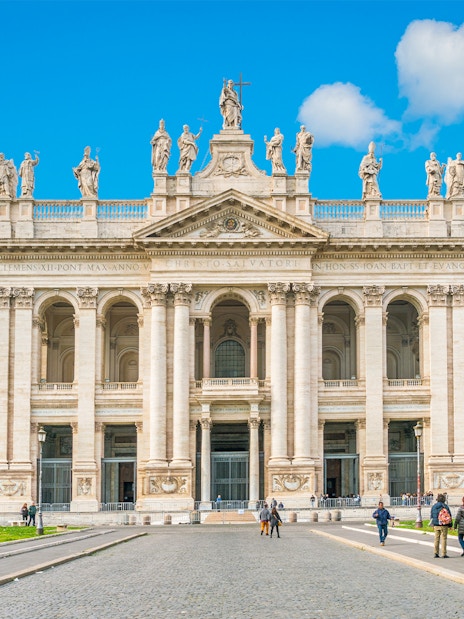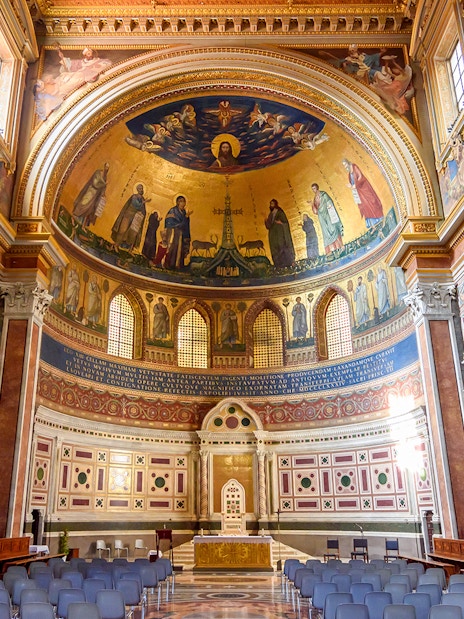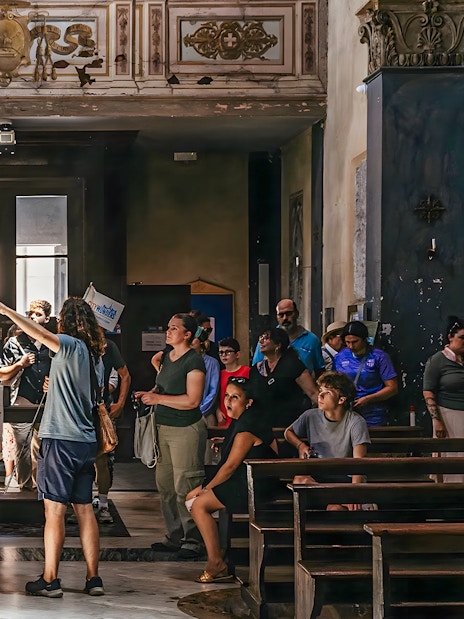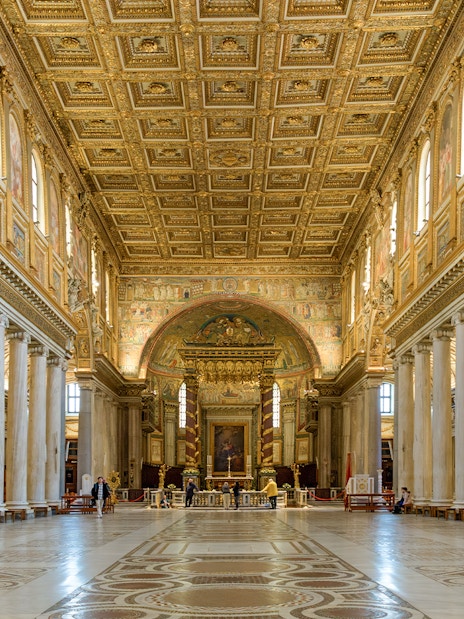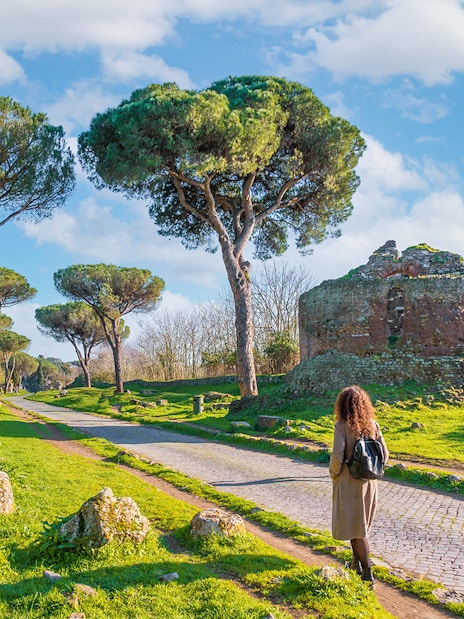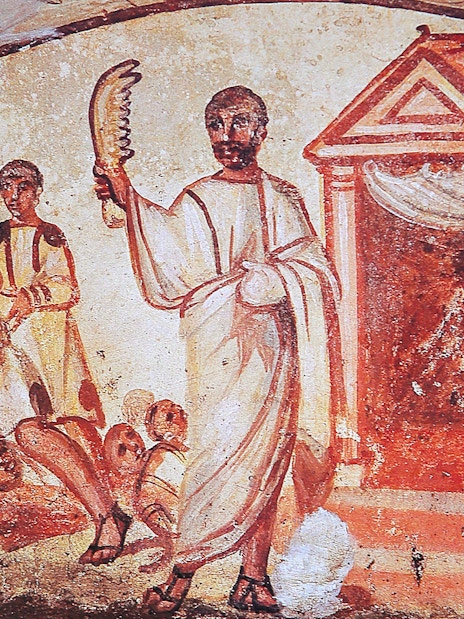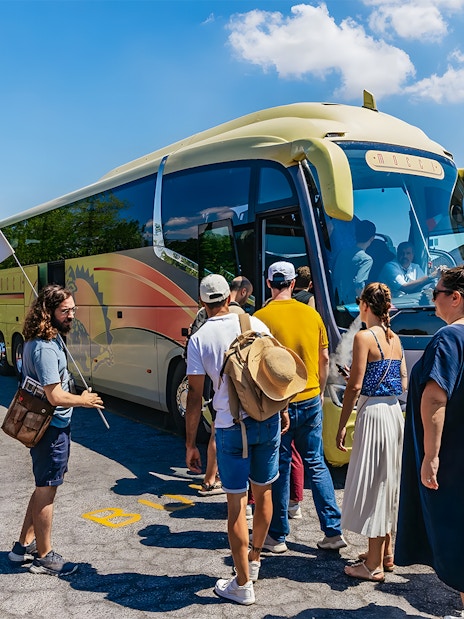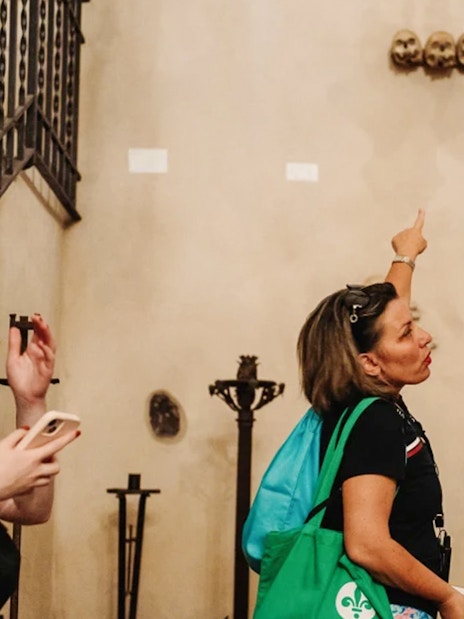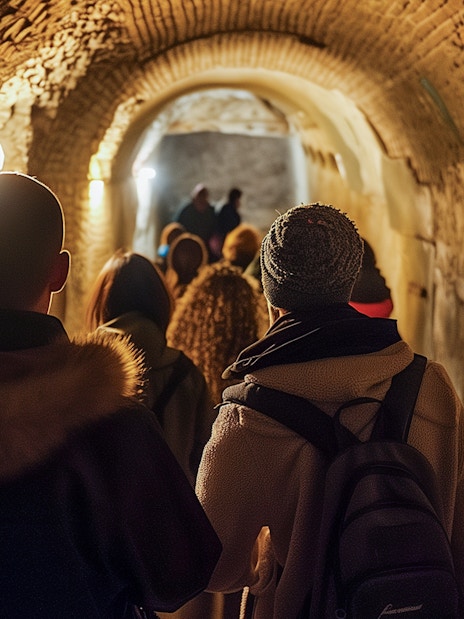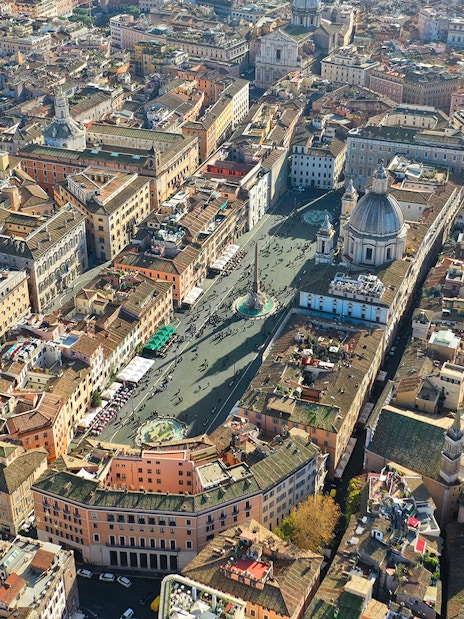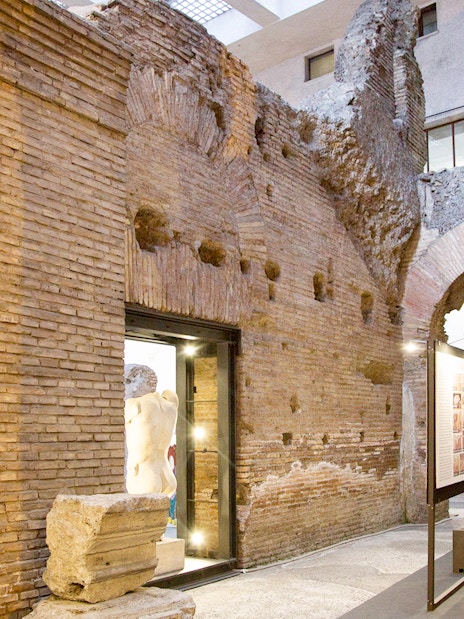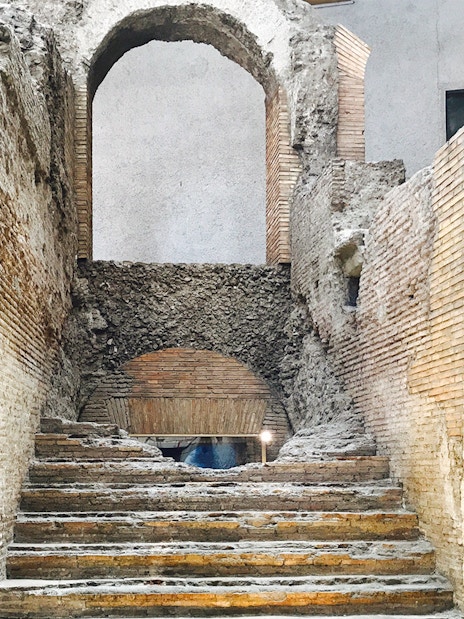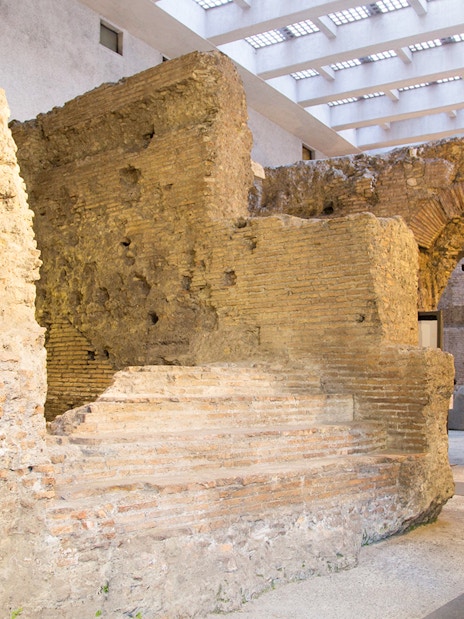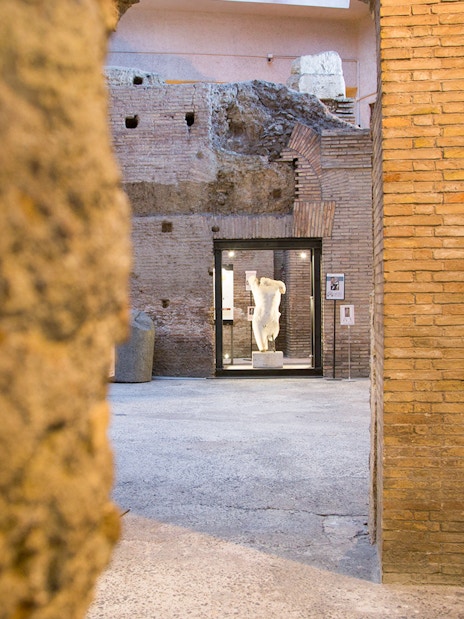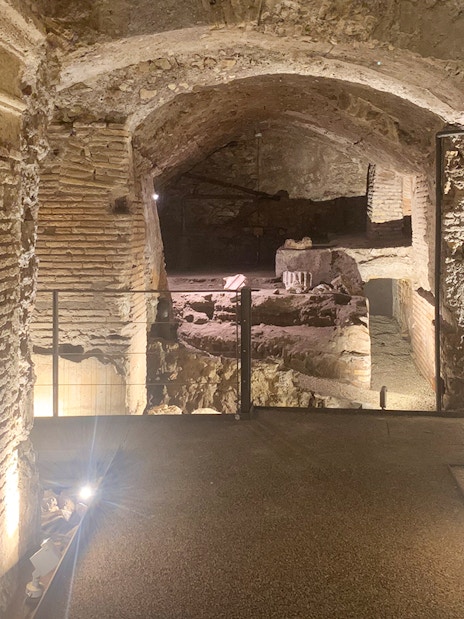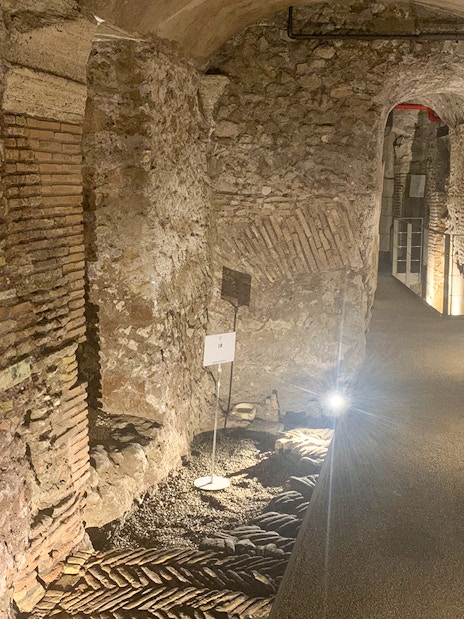- Roman Catacombs
- Capuchin Crypt
- Catacombs of Saint Sebastian
- Catacombs of Callixtus
- Catacombs of Domitilla
- San Nicola
- Catacombs of Saint Agnes
- Catacombs of Commodilla
- Catacombs of Priscilla
- History
- Appian Way
- Christian Catacombs
- Jewish Catacombs
- Colosseum
- Vatican Museums
- St. Peter's Basilica
- Castel Sant Angelo
- Rome Pantheon
- Borghese Gallery
- Bioparco Rome
- Big Bus Rome Hop-on Hop-off Tours
- Palazzo Barberini
- Musei Capitolini
- Leonardo da Vinci Museum
- Trevi Fountain Tours
- Altare della Patria
- Rome Underground Tours
- Mamertine Prison
- Santa Maria Maggiore Basilica
The Appian Way: Rome's ancient road of wonders

Explore Rome’s largest catacombs with an expert guide and optional transfers.
- Jump the long queues at the Catacombs of St. Callixtus, the final resting place of early Christians and popes, with an expert guide.
- Learn from your guide why this sacred underground site, once home to 16 popes, is called the “Little Vatican” and the meaning behind its fascinating frescoes and inscriptions.
- The catacombs are located outside the city center—opt for round-trip transfers for a seamless journey from Rome’s historic core.
- Extend your tour with transfer and entry to the eerie yet mesmerizing Capuchin Crypt, featuring skeletal artwork and a dive into monastic history.
Explore Rome’s largest catacombs with an expert guide and optional transfers.
- Jump the long queues at the Catacombs of St. Callixtus, the final resting place of early Christians and popes, with an expert guide.
- Learn from your guide why this sacred underground site, once home to 16 popes, is called the “Little Vatican” and the meaning behind its fascinating frescoes and inscriptions.
- The catacombs are located outside the city center—opt for round-trip transfers for a seamless journey from Rome’s historic core.
- Extend your tour with transfer and entry to the eerie yet mesmerizing Capuchin Crypt, featuring skeletal artwork and a dive into monastic history.
Inclusions
- Guided tour of Callixtus Catacombs with skip-the-line entry
- Expert English, Italian, German, or Spanish-speaking guide
- Round-trip transfers to the Catacombs (as per option selected)
- Capuchin Crypt access with audio guide and transfers (as per option selected)
Exclusions
- Hotel transfers
- Food & beverages
- Arrive atleast 15 minutes prior to your picked slot.
- There are 50 irregular steps to descend and ascend, with no seating area or elevator.
- Note that tours are not wheelchair accessible.
- There is a strict dress code to follow. Knees and shoulders must be covered due to religious sites.
- Photography and videography is prohibited inside the catacombs.
- These tickets can't be cancelled or rescheduled.
See the remains of 4,000 friars with fast-track entry and audio guide, or upgrade for transfers and guided catacombs tour.
- Skip the wait at long ticketing lines and walk straight into the chilling Capuchin Crypt at your chosen time slot.
- See the infamous bone-chilling artwork made of skulls and skeletons while learning about its history and symbolism with your audio guide.
- Level up your adventure on a combo guided tour of Domitilla (except Tuesdays) or St. Callixtus (Tuesdays only) Catacombs, complete with breezy open-bus transfers.
- Go all-in with a full package that includes the Catacombs, Capuchin Crypt, and San Nicola Basilica—plus round-trip AC coach transfers for a seamless experience.
See the remains of 4,000 friars with fast-track entry and audio guide, or upgrade for transfers and guided catacombs tour.
- Skip the wait at long ticketing lines and walk straight into the chilling Capuchin Crypt at your chosen time slot.
- See the infamous bone-chilling artwork made of skulls and skeletons while learning about its history and symbolism with your audio guide.
- Level up your adventure on a combo guided tour of Domitilla (except Tuesdays) or St. Callixtus (Tuesdays only) Catacombs, complete with breezy open-bus transfers.
- Go all-in with a full package that includes the Catacombs, Capuchin Crypt, and San Nicola Basilica—plus round-trip AC coach transfers for a seamless experience.
Inclusions
- Entry tickets to Museum & Crypt of the Capuchin Friars
- Audio guide
- Guided tour of the Domitilla Catacombs (except on Tuesdays) or St. Callixtus Catacombs (Tuesdays only) in English, Italian, German, French, or Spanish with one-way transfers (as per option selected)
- Guided tour of Christian Catacombs and Basilica of San Nicola with round-trip transfers(as per option selected)
- Arrive atleast 15 minutes prior to your picked slot.
- Minors are advised to enter the crypt only when accompanied by an adult.
- Children up to 6, visitors with disabilities (plus one companion), Capuchin friars, and national tourist guides enter for free.
- Note that tours are not wheelchair accessible.
- Photography and videography are prohibited inside the Catacombs.
- These tickets can't be cancelled or rescheduled.
Fast-track your way into Rome’s second-largest catacombs led by an expert—upgrade for comfy transfers.
- Ditch the ticket lines and dive into Domitilla’s 17km tunnels on a guided tour—Rome’s only catacombs with a still-standing underground basilica.
- Learn lesser-known details about the decorative arches, Biblical frescoes such as ‘Daniel with the lions’ and 'Noah's ark', and pagan-to-Christian burial shifts from your local guide.
- 30 meters down, find a semi-underground basilica unique to the Catacombs of Domitilla, dedicated to martyrs Nereus and Achileus!
- Elevate your tour with a visit to the Capuchin Crypt, where skulls and bones form chilling artwork, and scenic open bus transfers between the sites.
Fast-track your way into Rome’s second-largest catacombs led by an expert—upgrade for comfy transfers.
- Ditch the ticket lines and dive into Domitilla’s 17km tunnels on a guided tour—Rome’s only catacombs with a still-standing underground basilica.
- Learn lesser-known details about the decorative arches, Biblical frescoes such as ‘Daniel with the lions’ and 'Noah's ark', and pagan-to-Christian burial shifts from your local guide.
- 30 meters down, find a semi-underground basilica unique to the Catacombs of Domitilla, dedicated to martyrs Nereus and Achileus!
- Elevate your tour with a visit to the Capuchin Crypt, where skulls and bones form chilling artwork, and scenic open bus transfers between the sites.
Inclusions
- Guided tour of Domitilla Catacombs with skip-the-line entry
- Expert English, Italian, German, or Spanish-speaking guide
- Capuchin Crypt entry with audio guide and transfers (as per option selected)
Exclusions
- Hotel transfers
- Food & beverages
- Arrive atleast 15 minutes prior to your picked slot.
- There are several irregular steps to descend and ascend, with no seating area or elevator.
- There is a strict dress code to follow. Knees and shoulders must be covered due to religious sites.
- Photography and videography is prohibited inside the catacombs.
- If you have opted for the combo tour with Capuchin crypt, note that while Domitilla Catacombs are not available on Tuesdays, when the tour visits St. Callixtus Catacombs instead. Also the transfers would be till Capuchin Crypt only.
- You can cancel these tickets up to 24 hours before the experience begins and get a full refund.
Itinerary
START POINT
Central Rome
Meet your guide in the city center and climb aboard for a value-packed tour. Good news, if your hotel is in central Rome, you could be picked up from your lobby!
2 km
10 minutes
1
Holy Stairs
Within the Sancta Sanctorum next-door to the Archbasilica of Saint John Lateran lies this revered relic believed to be the very steps where Christ stood before Pontius Pilate!
0.14 km
1 minute
2
Archbasilica of St. John Lateran
This is Rome’s oldest and most prestigious basilica, and the pope’s official seat! Discover its grand Baroque architecture, stunning mosaics, and rich history with your expert guide.
1.5 km
3 minutes
3
Basilica of St. Mary Major
Marvel at the 5th-century mosaics in the nave depicting scenes from the life of the Virgin Mary, as well as an intricately decorated altar that houses the relics of the Holy Manger, believed to be from the nativity scene.
5.7 km
19 minutes
4
Catacombs of St. Callixtus
60 min
Tickets included
This vast underground labyrinth reveals early Christian history with ancient passageways, exquisite frescoes, and the resting places of popes and martyrs.
0.6 km
2 minutes
5
Catacombs of St. Sebastian
Tickets included
Glimpse into its underground basilica, serene chapels, and the revered tomb of St. Sebastian. Look out for Bernini's Salvatore Mundi marble bust representing Jesus.
7.5 km
25 minutes
6
END POINT
Central Rome
Tour Rome’s sacred landmarks—two Papal Basilicas and two ancient catacombs—in one experience.
- From Rome’s city center, head to the Sancta Sanctorum and glimpse the 'Holy Stairs', a relic of where Christ met Pontius Pilate before crucifixion!
- Visit the neighboring Archbasilica of St. John Lateran, seat of the pope, and the opulent Basilica of St. Mary Major atop Esquiline Hill.
- Next up, a trip down the winding catacombs of St. Callixtus and St. Sebastian where ancient Roman rituals, art, and engineering 'come alive'.
- Relax with comfortable transfers between each location. A guide in your language of choice offers detailed insights at every stop.
Tour Rome’s sacred landmarks—two Papal Basilicas and two ancient catacombs—in one experience.
- From Rome’s city center, head to the Sancta Sanctorum and glimpse the 'Holy Stairs', a relic of where Christ met Pontius Pilate before crucifixion!
- Visit the neighboring Archbasilica of St. John Lateran, seat of the pope, and the opulent Basilica of St. Mary Major atop Esquiline Hill.
- Next up, a trip down the winding catacombs of St. Callixtus and St. Sebastian where ancient Roman rituals, art, and engineering 'come alive'.
- Relax with comfortable transfers between each location. A guide in your language of choice offers detailed insights at every stop.
Inclusions
- Guided tour of the Holy Stairs at Sancta Sanctorum
- Guided tour of St. John Lateran Archbasilica & St. Mary Major Basilica
- Guided tour of St. Callixtus & St. Sebastian Catacombs with entry
- Expert English, Italian, or Spanish-speaking guide
- Round-trip AC coach transfers from central Rome
- Tip: Find spiritually significant artworks and relics in the chapel at the top of the Holy Staircase.
- This experience is not wheelchair accessible, and not recommended for those with claustrophobia or serious mobility issues.
- Strict dress code: Clothing that covers the knees and shoulders.
- Photography and videography is prohibited inside the catacombs.
- You can cancel these tickets up to 7 days before the experience begins and get a full refund.
Itinerary
START POINT
Piazza d'Aracoeli
Begin your guided tour from this central location in Rome, and end it at the Capuchin Crypt.
6 km
18 minutes
1
Catacombs of Domitilla
40 min
Tickets included
Home to some of the grandest cubicula around, these catacombs boast an intricate network of tunnels and a 2nd-century semi-undergound Basilica dedicated to Saints Nereus and Achilleus.
6.8 km
22 minutes
2
Museum & Crypt of the Capuchin Friars
Tickets included
This part of the tour is unguided – turn up your audio guide and independently explore the hauntingly beautiful chapels decorated by skeletal art, blending the macabre with the spiritual.
3
Crypts & Catacombs: Art made of Bone, dark stories of burial chambers, and no travel stress.
- Travel hassle-free with pre-arranged transfers, skipping the stress of navigating these offbeat, spread-out sites on your own.
- Explore the ancient Catacombs of Domitilla or St. Callixtus (on Tuesday) with a guide, see frescoed tombs, underground basilicas, and the resting places of early Christians.
- Visit the eerie Capuchin Crypt, where bones of 4,000 friars form intricate memento mori artwork, and learn about its history with an audio guide.
Crypts & Catacombs: Art made of Bone, dark stories of burial chambers, and no travel stress.
- Travel hassle-free with pre-arranged transfers, skipping the stress of navigating these offbeat, spread-out sites on your own.
- Explore the ancient Catacombs of Domitilla or St. Callixtus (on Tuesday) with a guide, see frescoed tombs, underground basilicas, and the resting places of early Christians.
- Visit the eerie Capuchin Crypt, where bones of 4,000 friars form intricate memento mori artwork, and learn about its history with an audio guide.
Inclusions
- Half-day tour around Domitilla Catacombs and Capuchin Crypt
- Guided tour of Domitilla Catacombs with entry (except Tuesday)
- Guided tour of St. Callixtus Catacombs with entry (only Tuesday)
- Expert English, Italian, German, French, or Spanish-speaking guide
- One-way transfers
- Entry to the Museum & Crypt of the Capuchin Friars with audio guide
Exclusions
- Guided tour of the Museum & Crypt of the Capuchin Friars
- Return transfers to Rome
- Hotel pick-up and drop-off
- Food & beverages
- Arrive at least 15 minutes prior to your picked slot, as latecomers would not be accommodated.
- This experience is not wheelchair accessible, and not recommended for those with claustrophobia or serious mobility issues.
- Strict dress code: Clothing that covers the knees and shoulders.
- Photography and videography is prohibited inside the catacombs.
- You can cancel these tickets up to 24 hours before the experience begins and get a full refund.
Discover Rome’s somber past, exploring its second-largest catacombs featuring an underground basilica.
- Enjoy priority access to the Catacombs of Domitilla and explore this vast underground world with an expert guide.
- Hear all about early Christian burial practices and their significance from expert guides in your chosen language.
- 30 meters down, find a semi-underground basilica unique to the Catacombs of Domitilla, dedicated to martyrs Nereus and Achileus.
Discover Rome’s somber past, exploring its second-largest catacombs featuring an underground basilica.
- Enjoy priority access to the Catacombs of Domitilla and explore this vast underground world with an expert guide.
- Hear all about early Christian burial practices and their significance from expert guides in your chosen language.
- 30 meters down, find a semi-underground basilica unique to the Catacombs of Domitilla, dedicated to martyrs Nereus and Achileus.
Inclusions
- Guided tour of Domitilla Catacombs with entry
- Expert English, Italian, German, or Spanish-speaking guide
Exclusions
- Round-trip transfers from Rome
- Please arrive 15 minutes prior to your chosen slot, as latecomers would not be accommodated.
- This experience is not wheelchair accessible, and not recommended for those with claustrophobia or serious mobility issues.
- There are several irregular steps to descend and ascend, with no seating area or elevator.
- Strict dress code: Clothing that covers the knees and shoulders.
- Photography and videography is prohibited inside the catacombs.
- You can cancel these tickets up to 24 hours before the experience begins and get a full refund.
- Explore Rome's underground stadium complex on this audio-guided tour.
- Learn more about the stadium and its history from your audio guide, available in multiple languages.
- See many artifacts from the days of the Roman Empire found during archaeological excavations, including fragments of sculptures and more.
- Explore Rome's underground stadium complex on this audio-guided tour.
- Learn more about the stadium and its history from your audio guide, available in multiple languages.
- See many artifacts from the days of the Roman Empire found during archaeological excavations, including fragments of sculptures and more.
Inclusions
- Entrance to the underground archaeological site of the Stadium of Domitian
- Audioguide in Spanish, English, French, German, Italian, Portuguese & Russian
- Keep in mind, bottles, glasses containers, alcoholic beverages, aerosols, large luggage or bags and pets are not allowed on this experience. Pack wisely!
- This experience is not wheelchair accessible.
- This experience is pram/stroller accessible.
- Choose safety and comfort: This experience is not the best fit for guests with the claustrophobia of small spaces.
- You can cancel these tickets up to 24 hours before the experience begins and get a full refund.
Top things to do in Rome
Quick Facts about Appian Way

- Official name: Via Appia Antica
- Location: Via Appia Antica, 42, 00178 Roma RM, Italy
- Date of opening: 312 BC
- Architect: Appius Claudius Caecus (for the original construction)
- Architectural style: Ancient Roman
- UNESCO World Heritage Site: Declared in 1980
- Number of visitors per year: Over 500,000
- Function: Important ancient road connecting Rome to southeastern Italy.
Why Visit the Appian Way?

- Explore ancient Rome: Walk in the footsteps of ancient Romans and discover the historical significance of the road that connected Rome to the rest of Italy.
- Historic mausoleums: Admire the stunning architecture and intricate carvings of the many mausoleums along the way, including the Mausoleum of Cecilia Metella and the Tomb of Seneca.
- Catacombs: Journey underground and explore the Catacombs of San Callisto, one of the largest and most significant Christian burial sites in Rome.
- Natural Beauty: Enjoy the stunning views of the Italian countryside, as well as the lush vegetation and wildlife along the route.
- Visit the museums: Visit the many museums that dot the Appian Way, including the Museum of Roman Civilization and the Museum of the Walls, to learn more about the history and significance of the ancient road.
- Outdoor activities: Go cycling, hiking, or horseback riding along the scenic route and explore the beauty of nature at its best.
Plan Your Visit to the Appian Way

What is the Appian Way Opening Hours?
The Appian Way is open to visitors 24/7. However, the archaeological sites along the way have varying hours depending on the season and day of the week. You should ensure that you check the individual attraction's opening hours before visiting.
Best Time to Visit: During the spring and fall months when the weather is mild. Additionally, visiting in the early morning or late afternoon ensures fewer crowds.
Rome Catacombs' Opening Hours
Where is the Appian Way Located?
Address: Via Appia Antica, 42, 00178 Roma RM, Italy
The Appian Way is located in the southeastern part of Rome, just outside the city walls. It stretches for about 10 miles from the city center to the countryside.
Getting There
To reach the Appian Way, you can take the metro to the Colli Albani stop and then a bus heading to Appio Latino or Ardeatina. Alternatively, you can take bus number 118 from the Piramide station.
Highlights of the Appian Way

Catacombs
Visitors can explore the underground burial chambers and see the ancient artwork and inscriptions that decorate the walls. Some of the most notable catacombs along the Appian Way include the Catacombs of San Callisto, San Sebastiano, and Domitilla.

Aqueducts
The Appian Way is also home to several impressive aqueducts, which were once used to transport water into the city. The most prominent of these is the Aqua Claudia, which dates back to the 1st century AD. Visitors can see the towering arches and intricate engineering that went into these massive structures.

Churches
The Appian Way is dotted with several beautiful churches that are well worth a visit. Some of the most notable include the Basilica of St. John Lateran, the Basilica of Santa Maria in Cosmedin, and the Church of the Domine Quo Vadis. These buildings showcase a range of architectural styles and are filled with stunning artwork and religious relics.

Villas
The Appian Way is home to several impressive villas, a must-see for those interested in ancient Roman architecture. The most famous of these is the Villa of the Quintilii, which was once owned by the powerful Quintilii brothers. Visitors can explore the villa's impressive ruins and see the intricate mosaics and frescoes that adorn the walls.
History of the Appian Way

The Appian Way is one of the oldest and most important roads in ancient Rome. Its history dates back to its construction in 312 BC, commissioned by the Roman Republic and overseen by Appius Claudius Caecus, a prominent Roman patrician and politician. The road served as a vital artery for Rome, originally intended to connect Rome with Capua, a city in southern Italy. However, it was later extended to Brindisi, a port city on the Adriatic Sea.
The construction of the Appian Way faced numerous challenges, including rocky terrains and swampy areas, which required innovative engineering techniques for stability. Over the centuries, the road was widened and improved, playing a significant role in Rome's transportation and commerce.
The Appian Way was an important military and commercial route for the Roman Empire. It was used to transport troops and supplies and to facilitate trade between Rome and the rest of the Mediterranean world. The road was also a popular pilgrimage route, and many Christian saints are said to have traveled along it.
Frequently Asked Questions about Appian Way
Appian Way is one of the most important ancient roads in Rome, Italy, which dates back to 312 BC. It was built to connect Rome to Brindisi, in southern Italy.
Entry to the Appian Way and its attractions is generally free. However, some museums or guided tours may have admission fees. You can purchase tickets for them online or at the respective ticket counters. We recommend buying them online to avoid the odds of tickets selling out on the day of your visit.
The original construction of the Appian Way was overseen by Appius Claudius Caecus, a Roman patrician and politician.
The construction of the Appian Way began in 312 BC and continued over the following years, with subsequent improvements and expansions.
The Appian Way is home to several historical monuments such as the Tomb of Cecilia Metella, the Circus of Maxentius, the Catacombs of Rome, the Villa of the Quintilii, and the Mausoleum of Caecilia Metella.
There are many things to see and do on the Appian Way. Some of the tourist attractions along the Appian Way include the Catacombs of San Callisto and the Catacombs of San Sebastiano as well as various basilicas and tombs. The stretch close to Rome of the Via Appia Antica is now part of a nature and archaeological park, the Parco Regionale dell’Appia Antica
The best time to visit the Appian Way is during spring and autumn when the weather is pleasant, and there are fewer tourists. However, it can get crowded during peak season.
The Appian Way is located in Rome, Italy. Its address is Via Appia Antica, Rome.
The easiest way to reach the Appian Way is by taking the metro to the Colli Albani stop and then taking a bus heading to Appio Latino or Ardeatina. You can also reach here by taxi.
It depends on your interest, but you should keep at least a half-day to explore the area and appreciate the ancient monuments in a leisurely way. However, if you are a history buff, you can easily spend a whole day here.
It is recommended to wear comfortable shoes and casual clothing as you need to walk around a lot. Remember to carry a hat, sunscreen, and a bottle of water during summer.

